美式英语发音规则概要
- 格式:doc
- 大小:69.50 KB
- 文档页数:6
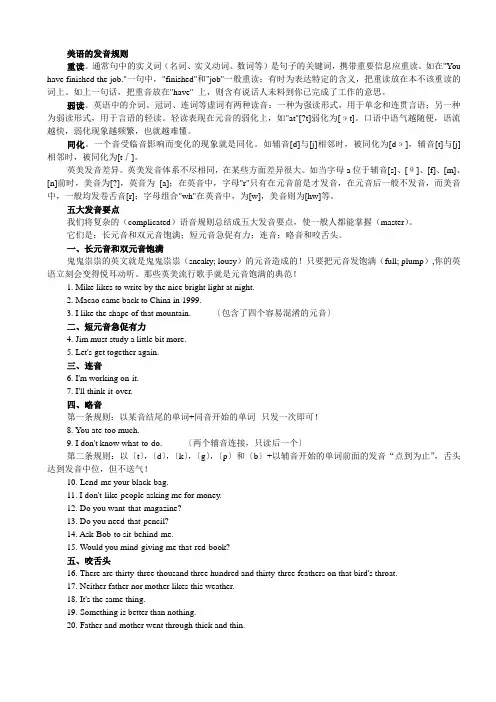
美语的发音规则重读。
通常句中的实义词(名词、实义动词、数词等)是句子的关键词,携带重要信息应重读。
如在"You have finished the job."一句中,"finished"和"job"一般重读;有时为表达特定的含义,把重读放在本不该重读的词上。
如上一句话,把重音放在"have" 上,则含有说话人未料到你已完成了工作的意思。
弱读。
英语中的介词、冠词、连词等虚词有两种读音:一种为强读形式,用于单念和连贯言语;另一种为弱读形式,用于言语的轻读。
轻读表现在元音的弱化上,如"at"[?t]弱化为[эt]。
口语中语气越随便,语流越快,弱化现象越频繁,也就越难懂。
同化。
一个音受临音影响而变化的现象就是同化。
如辅音[d]与[j]相邻时,被同化为[dэ],辅音[t]与[j]相邻时,被同化为[t∫]。
英美发音差异。
英美发音体系不尽相同,在某些方面差异很大。
如当字母a位于辅音[s]、[θ]、[f]、[m]、[n]前时,美音为[?],英音为[a];在英音中,字母"r"只有在元音前是才发音,在元音后一般不发音,而美音中,一般均发卷舌音[r];字母组合"wh"在英音中,为[w],美音则为[hw]等。
五大发音要点我们将复杂的(complicated)语音规则总结成五大发音要点,使一般人都能掌握(master)。
它们是:长元音和双元音饱满;短元音急促有力;连音;略音和咬舌头。
一、长元音和双元音饱满鬼鬼祟祟的英文就是鬼鬼祟祟(sneaky; lousy)的元音造成的!只要把元音发饱满(full; plump),你的英语立刻会变得悦耳动听。
那些英美流行歌手就是元音饱满的典范!1. Mike likes to write by the nice bright light at night.2. Macao came back to China in 1999.3. I like the shape of that mountain. 〔包含了四个容易混淆的元音〕二、短元音急促有力4. Jim must study a little bit more.5. Let's get together again.三、连音6. I'm working on-it.7. I'll think-it-over.四、略音第一条规则:以某音结尾的单词+同音开始的单词--只发一次即可!8. You ate-too much.9. I don't know what-to-do. 〔两个辅音连接,只读后一个〕第二条规则:以〔t〕,〔d〕,〔k〕,〔g〕,〔p〕和〔b〕+以辅音开始的单词前面的发音“点到为止”,舌头达到发音中位,但不送气!10. Lend-me your black-bag.11. I don't-like-people asking me for money.12. Do you want-that-magazine?13. Do you need-that-pencil?14. Ask-Bob-to sit-behind-me.15. Would you mind-giving me that-red-book?五、咬舌头16. There are thirty-three thousand three hundred and thirty-three feathers on that bird's throat.17. Neither father nor mother likes this weather.18. It's the same thing.19. Something is better than nothing.20. Father and mother went through thick and thin.地道美国味速成最能体现“美国味”的发音都集中在下面的句子中。
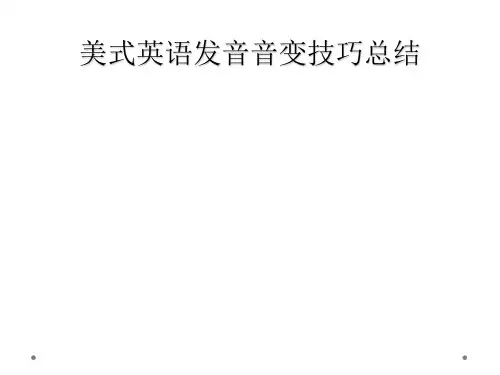
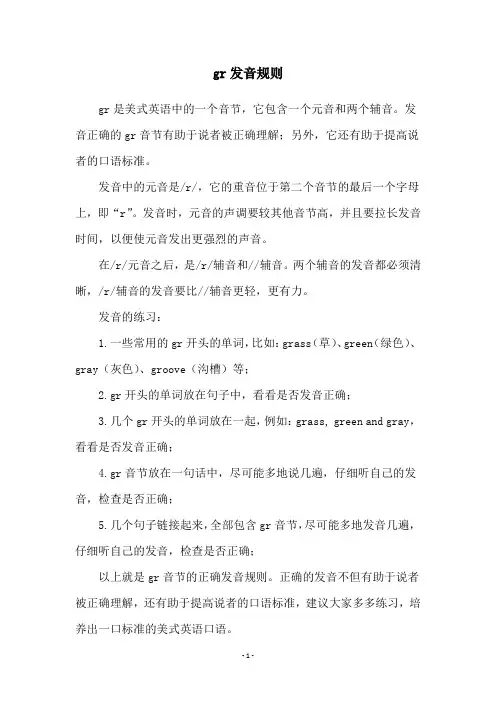
gr发音规则gr是美式英语中的一个音节,它包含一个元音和两个辅音。
发音正确的gr音节有助于说者被正确理解;另外,它还有助于提高说者的口语标准。
发音中的元音是/r/,它的重音位于第二个音节的最后一个字母上,即“r”。
发音时,元音的声调要较其他音节高,并且要拉长发音时间,以便使元音发出更强烈的声音。
在/r/元音之后,是/r/辅音和//辅音。
两个辅音的发音都必须清晰,/r/辅音的发音要比//辅音更轻,更有力。
发音的练习:1.一些常用的gr开头的单词,比如:grass(草)、green(绿色)、gray(灰色)、groove(沟槽)等;2.gr开头的单词放在句子中,看看是否发音正确;3.几个gr开头的单词放在一起,例如:grass, green and gray,看看是否发音正确;4.gr音节放在一句话中,尽可能多地说几遍,仔细听自己的发音,检查是否正确;5.几个句子链接起来,全部包含gr音节,尽可能多地发音几遍,仔细听自己的发音,检查是否正确;以上就是gr音节的正确发音规则。
正确的发音不但有助于说者被正确理解,还有助于提高说者的口语标准,建议大家多多练习,培养出一口标准的美式英语口语。
正确的发音不仅需要口形纠正和声调调整,还可以通过系统的学习、多次练习、及时反馈来获得,也可以通过与朋友大量的交流来纠正发音,也可以通过听录音来反复比对。
同时,对于一些比较难区分发音的单词,应多花精力进行记忆和练习,以便熟悉发音。
发音中,关于/r/音节的正确发音,所有参与者都应牢记以上几点:1.音的重音位于最后一个字母上,即“r”;2.调要较其他音节高,并且要拉长发音时间;3. /r/辅音的发音要比//辅音更轻,更有力;4.音时要清晰;5.过系统学习、多次练习、及时反馈,通过与朋友大量的交流来纠正发音,通过听录音来反复比对等方法来获得正确的发音;6.于一些比较难区分发音的单词,需要多花精力进行记忆和练习,以便熟悉发音。
说到底,要想掌握正确的gr音节发音,最重要的是坚持不懈地练习,只有通过反复练习,才能形成良好习惯,达到熟练水平,使说者被正确理解、提高口语标准,发出标准的美式英语口语。
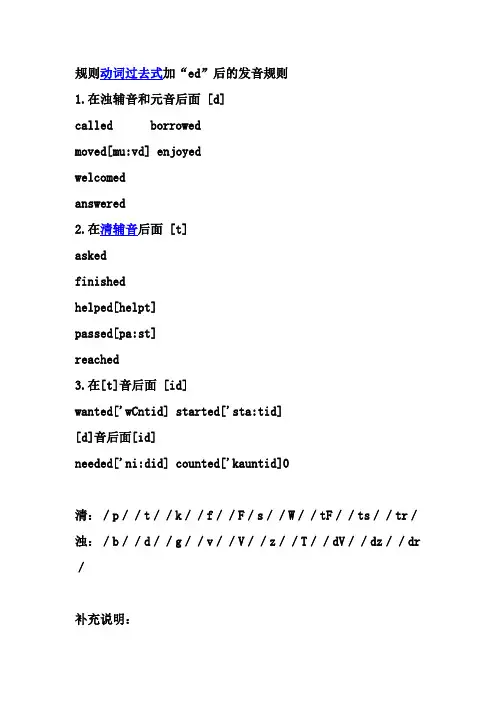
规则动词过去式加“ed”后的发音规则1.在浊辅音和元音后面 [d]called borrowedmoved[mu:vd] enjoyedwelcomedanswered2.在清辅音后面 [t]askedfinishedhelped[helpt]passed[pa:st]reached3.在[t]音后面 [id]wanted['wCntid] started['sta:tid][d]音后面[id]needed['ni:did] counted['kauntid]0清:/p//t//k//f//F/s//W//tF//ts//tr/浊:/b//d//g//v//V//z//T//dV//dz//dr /补充说明:规则动词的过去式由“动词原形+-ed”构成,具体变化有:1. 直接在词尾加-ed。
如: want—wanted, work—worked, need—needed, clean—cleaned2. 以不发音的e结尾的在词尾加-d。
如:like—liked, live—lived, use—used, move—moved3. 以一个元音字母加一个辅音字母结尾的重读闭音节动词,先双写结尾的辅音字母,再加-ed。
如:stop—stopped, trip—tripped4. 以辅音字母加y结尾的动词,先把y变成i,再加-ed。
如:study—studied, carry—carried, hurry—hurried, marry—married不规则动词的过去式大体上归纳有以下六条记忆法:1. 以t结尾的词,过去式与原形相同。
如:put—put, let—let, cut—cut, beat—beat2. 以d结尾的词,把d变成t。
如:build—built, lend—lent, send—sent, spend—spent3. 以n结尾的词,在词后加t。
如:mean—meant, burn—burnt, learn—learnt4. 以ow / aw结尾的词,把ow / aw变成ew。
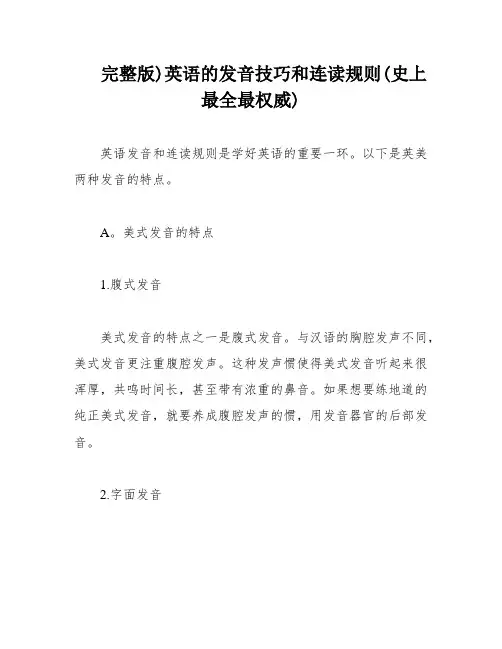
完整版)英语的发音技巧和连读规则(史上最全最权威)英语发音和连读规则是学好英语的重要一环。
以下是英美两种发音的特点。
A。
美式发音的特点1.腹式发音美式发音的特点之一是腹式发音。
与汉语的胸腔发声不同,美式发音更注重腹腔发声。
这种发声惯使得美式发音听起来很浑厚,共鸣时间长,甚至带有浓重的鼻音。
如果想要练地道的纯正美式发音,就要养成腹腔发声的惯,用发音器官的后部发音。
2.字面发音美式发音的单词发音更加规则,一般单词的发音与其拼写相符。
例如卷舌音[r]的处理,在美式发音中只要有字母r,就要卷舌;反之,没有字母r,发音就不要卷舌。
3.强弱分明美式发音的节奏是有重读和弱读交替而产生的,所以要让自己的话说出来有节奏感,就要重读该重读的音节,弱读该弱读的地方,达到强弱分明的原则。
同时,单词的重音也要注意,不能随便移动单词的重音,要弱读没有重音的音节,避免重读第二个音节。
B。
英式发音的特点1.共振焦点英式发音的共振焦点在牙齿前面、嘴唇之间,嘴唇和面部肌肉运动得更多,也就是所谓的“发音靠前”。
与之不同的是,美式发音的共振焦点在口腔中后部的舌与腭之间,也就是“发音靠后”。
2.音调变化美式发音的音调只在音节之间变化,而不在音节之内变化。
音节之内没有音高的滑动;英式发音则通过音高的滑动来用于强调逻辑上重要的词语。
3.元音差异英式发音中有三个主要元音总是不同于美式发音。
例如/o/在美式发音中是两段式发音,而在英式发音中前面加上了一个/?/的音,变成了三段式。
英式发音的/?/短促有力,嘴唇快速滑动,口形变小。
英式发音的/?:/发音时,双唇要前伸很远,并弯成圆形,只留下很小的开口。
4.音变现象有一些音在英式发音中只是有时不同于美式发音。
例如/i:/在单词结尾(尤其是拼写作y或ly)时弱化为/i/,例如pretty、mostly。
在美式发音中,带/?ri/、/ori/的音节常被重读,而英式发音则弱化为/?ri/,重音前移,例如necesary、ordinary、category。
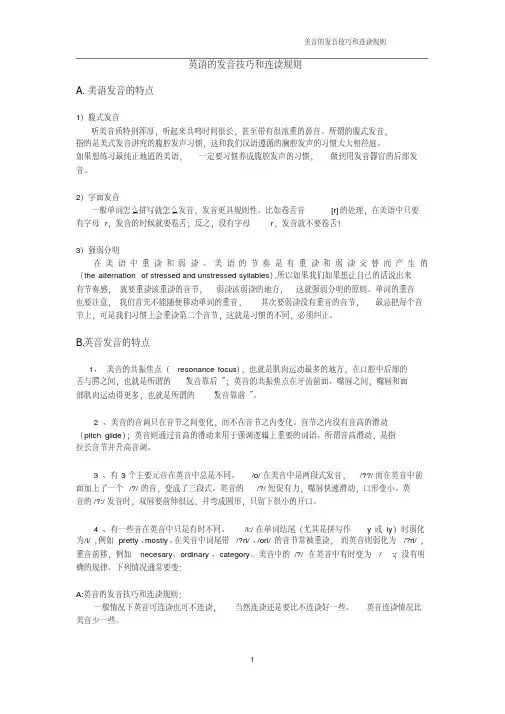
英语的发音技巧和连读规则A.美语发音的特点1)腹式发音听美音质特别浑厚,听起来共鸣时间很长,甚至带有很浓重的鼻音。
所谓的腹式发音,指的是美式发音讲究的腹腔发声习惯,这和我们汉语遵循的胸腔发声的习惯大大相径庭。
如果想练习最纯正地道的美语,一定要习惯养成腹腔发声的习惯,做到用发音器官的后部发音。
2)字面发音一般单词怎么拼写就怎么发音,发音更具规则性。
比如卷舌音[r]的处理,在美语中只要有字母r,发音的时候就要卷舌;反之,没有字母r,发音就不要卷舌!3)强弱分明在美语中重读和弱读。
美语的节奏是有重读和弱读交替而产生的(the alternation of stressed and unstressed syllables),所以如果我们如果想让自己的话说出来有节奏感,就要重读该重读的音节,弱读该弱读的地方,这就强弱分明的原则。
单词的重音也要注意,我们首先不能随便移动单词的重音,其次要弱读没有重音的音节,最忌把每个音节上,可是我们习惯上会重读第二个音节,这就是习惯的不同,必须纠正。
B.英音发音的特点1、美音的共振焦点(resonance focus),也就是肌肉运动最多的地方,在口腔中后部的舌与腭之间,也就是所谓的“发音靠后”;英音的共振焦点在牙齿前面、嘴唇之间,嘴唇和面部肌肉运动得更多,也就是所谓的“发音靠前”。
2、美音的音调只在音节之间变化,而不在音节之内变化。
音节之内没有音高的滑动(pitch glide);英音则通过音高的滑动来用于强调逻辑上重要的词语。
所谓音高滑动,是指拉长音节并升高音调。
3、有3个主要元音在英音中总是不同。
/o/在美音中是两段式发音,/??/而在英音中前面加上了一个/?/的音,变成了三段式。
英音的/?/短促有力,嘴唇快速滑动,口形变小。
英音的/?:/发音时,双唇要前伸很远,并弯成圆形,只留下很小的开口。
4、有一些音在英音中只是有时不同。
/i:/在单词结尾(尤其是拼写作y或ly)时弱化为/i/,例如pretty、mostly。
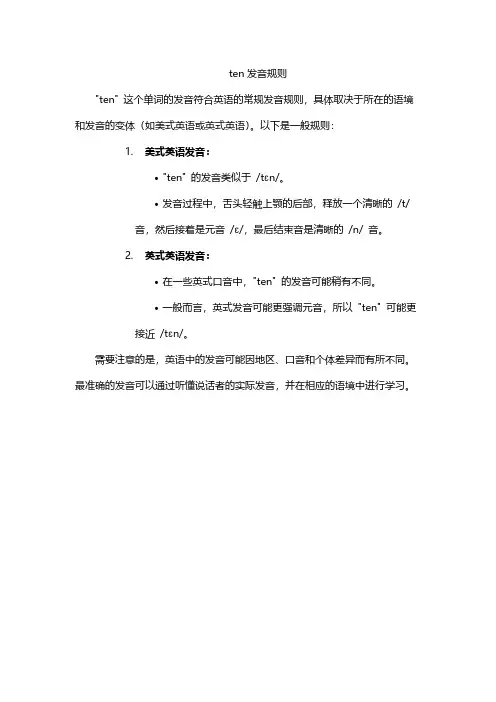
ten发音规则
"ten" 这个单词的发音符合英语的常规发音规则,具体取决于所在的语境和发音的变体(如美式英语或英式英语)。
以下是一般规则:
1.美式英语发音:
•"ten" 的发音类似于/tɛn/。
•发音过程中,舌头轻触上颚的后部,释放一个清晰的/t/ 音,然后接着是元音/ɛ/,最后结束音是清晰的/n/ 音。
2.英式英语发音:
•在一些英式口音中,"ten" 的发音可能稍有不同。
•一般而言,英式发音可能更强调元音,所以"ten" 可能更接近/tɛn/。
需要注意的是,英语中的发音可能因地区、口音和个体差异而有所不同。
最准确的发音可以通过听懂说话者的实际发音,并在相应的语境中进行学习。

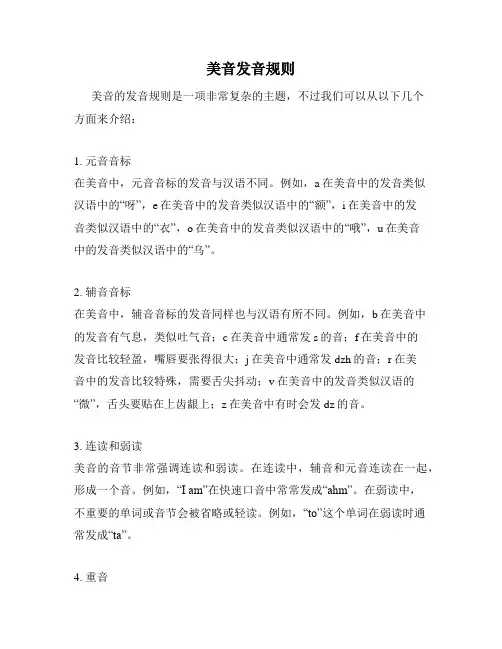
美音发音规则美音的发音规则是一项非常复杂的主题,不过我们可以从以下几个方面来介绍:1. 元音音标在美音中,元音音标的发音与汉语不同。
例如,a在美音中的发音类似汉语中的“呀”,e在美音中的发音类似汉语中的“额”,i在美音中的发音类似汉语中的“衣”,o在美音中的发音类似汉语中的“哦”,u在美音中的发音类似汉语中的“乌”。
2. 辅音音标在美音中,辅音音标的发音同样也与汉语有所不同。
例如,b在美音中的发音有气息,类似吐气音;c在美音中通常发s的音;f在美音中的发音比较轻盈,嘴唇要张得很大;j在美音中通常发dzh的音;r在美音中的发音比较特殊,需要舌尖抖动;v在美音中的发音类似汉语的“微”,舌头要贴在上齿龈上;z在美音中有时会发dz的音。
3. 连读和弱读美音的音节非常强调连读和弱读。
在连读中,辅音和元音连读在一起,形成一个音。
例如,“I am”在快速口音中常常发成“ahm”。
在弱读中,不重要的单词或音节会被省略或轻读。
例如,“to”这个单词在弱读时通常发成“ta”。
4. 重音在美音中,有些音节会发重音,而有些则发轻音。
重音通常会放在单词的第一个音节上,但也有例外。
例如,“picture”这个单词的重音在第二个音节上。
5. 浊音和清音在美音中,辅音可以被划分为浊音和清音。
浊音通常带有气息,例如b、g和d等。
清音则没有气息,例如p、k和t等。
总之,美音的发音规则非常繁琐,需要大量练习才能掌握。
但只要你能花时间去练习和听原版美剧,相信你也能成为一名擅长美音发音的人!。
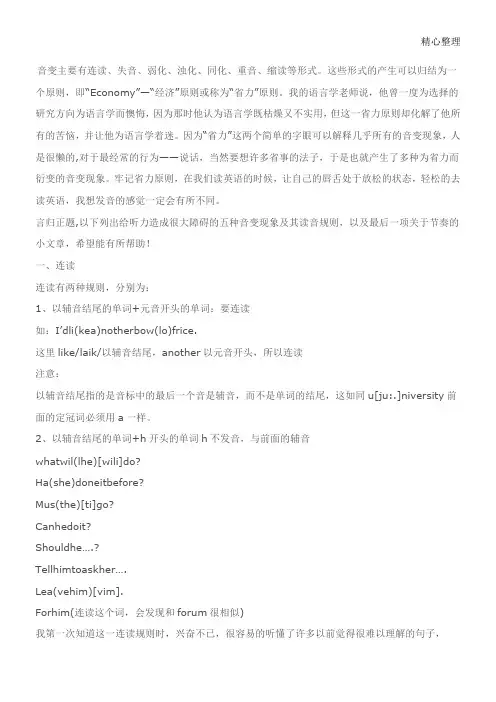
精心整理音变主要有连读、失音、弱化、浊化、同化、重音、缩读等形式。
这些形式的产生可以归结为一个原则,即“Economy”—“经济”原则或称为“省力”原则。
我的语言学老师说,他曾一度为选择的研究方向为语言学而懊悔,因为那时他认为语言学既枯燥又不实用,但这一省力原则却化解了他所有的苦恼,并让他为语言学着迷。
因为“省力”这两个简单的字眼可以解释几乎所有的音变现象,人是很懒的,对于最经常的行为——说话,当然要想许多省事的法子,于是也就产生了多种为省力而衍变的音变现象。
牢记省力原则,在我们读英语的时候,让自己的唇舌处于放松的状态,轻松的去言归正题一、连读1如:这里注意:前面的定冠词必须用a 一样。
2、以辅音结尾的单词+h 开头的单词h 不发音,与前面的辅音whatwil(lhe)[wili]do? Ha(she)doneitbefore?Mus(the)[ti]go?Canhedoit?Shouldhe….?Tellhimtoaskher….Lea(vehim)[vim].Forhim(1、辅音2、辅音3、辅音三、失音由于失去爆破是失音的一种现象,摩擦音也会被失去,所以统称为失音。
注意:爆破音并不是完全失去,仍然形成阻碍,把气流堵在里面,但不爆破,直接发出相邻的辅音。
规则:1、辅音爆破音或摩擦音后面跟的是爆破音、破擦音和摩擦等,前面的辅音要失去爆破。
这样的例子有很多很多,红色标注的辅音不发音:Sitdown:发音再次的老师都不会发出[t]音Contactlens:Bigcake四、浊化1、[S]Stand:2如:writer,听起来和rider的发音几乎没有区别letter—ladderoutof美国人和加拿大人发音为了省事,习惯清音浊化,尤其是[t]在单词的中间一定会浊化成[d],但英国人发音不会这样,这也是英音和美音的一大区别。
了解这一浊化原则,会给听力带来一些帮助。
五、弱读一般来说:实词重读,如动词、名词、副词等;六、节奏不过在看老外教你十年寒窗苦读英语,为谁辛苦为谁忙?当然是用来和老外“侃”喽。
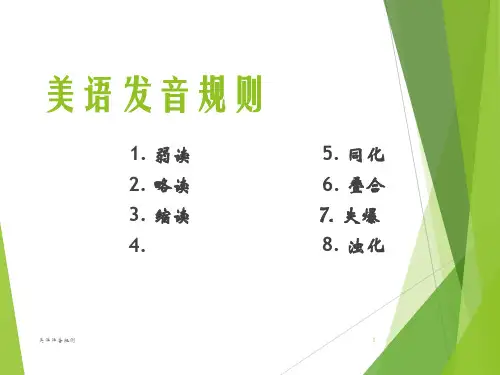
美式英语连读略读规则美式英语中的连读和略读一、连读1.词尾辅音 +词首元音Stand?up.2.词尾元音 +词首元音(包含同一个单词以内如snowing)元音 [u]等结尾 +元音开头,中间加上一个较轻的/w/Just do it.元音 [i] 等结尾 +元音开头,中间加上一个较弱的/j/ 。
I am Chinese.3.词尾不发音 r 或 re+词首元音,词尾r 发音 /r/ 。
如: Where?are your brother?and sister当存心群进行停立时不行连读。
Is?it a hat or?a cat( hat 与 or 之间不能够连读)4.词尾辅音 +词首辅音(包含同一个单词以内如football )①爆破音 +爆破音 /p,b,t,d,k,g/ ,失掉爆破sit down②爆破音 +摩擦音 /f,v,s,z,?,?, θ ,e,r,h/不完整爆破good friends③爆破音 +破擦音 /t ?,d?,tr,dr, ts,dz/ 不完整爆破picture④爆破音与鼻辅音 /m,n,?/ 相邻时,在词中,不完整爆破;在词尾,鼻腔爆破。
garden⑤爆破音与边辅音 /l/ 相邻时:在词中,不完整爆破;在词尾,舌侧爆破。
如:Lately/Badly/Mostly/Friendly Good luck At last假如词尾辅音与词首辅音一致,则只要要发一个。
Good day.5.连读中的同化(辅音加半元音连读)①/s/+/j/ →//?如: this year 等②/z/+/j/ →//? 如: What brings you here 什么风把你刮到这儿来了③ /t/+/j/ →//? 如: congratulation、last year 等④ /d/+/j/ →/? 如: education 等6.击穿连读①/h/ 很弱 ,简单被击穿 with+him=with(h)im with+her=with(h)er② /t/ 和/d/ 在/n/ 后往常被击穿twenty--twen(t)y internet--in(t)ernetwanted--wan(t)ed and+I=an(d) I③ /th/ 在/n/ 后有时也被击穿seen+that=seen (th)at I've never seen that movie.④with 后有弱读的元音 ,with 有时会变为 /wit/with+our=wit(h)ar with+it=wit(h)Di二、特别同化与浊化1.特别同化(因声带的影响而发生的同化)音可清音,如:of(v→f)course,his(z→s)pen,with( e→θ) pleasure。
英语四大发音规则很多学员总是有这样的困惑:同样的一句话,为什么老外讲出来的和我自己讲出来的差距那么大呢?其实每个单词我们都能发出来,但是在句子当中为什么就不能像老外讲的那么顺、那么流畅呢?其关键就在于你不了解连读、略读、变音及浊化这四大发音规则。
这些规则(其实并不是强制规则,只是约定俗成)是根据美国人口语当中出现的发音现象总结而来的,了解并掌握这些发音规则,不仅能使你讲出地道的美国口语,而且能让你的听力得到巨大的提升!一、连读规则:在同一意群中,前尾辅音+后头元音要连读。
例如:1、not –at-all; half- an- hour; I love -you and- all; after-all2、I'm working on-it. 我正在努力。
3. I'll think-it-over. 我会仔细考虑的。
二、略读规则:【第一条规则】以某辅音结尾的单词+同音开头的单词--只发后一个音即可。
比如:bus stop keep peace part time team memberI don't know what to do. 我不知道该做些什么。
〔两个辅音连接,只读后一个〕【第二条规则】爆破音〔p〕,〔b〕,〔t〕,〔d〕,〔k〕,〔g〕+以辅音开头的单词,前面的爆破音发音“点到为止”,有气无声!比如:keep fit rob me sit down next door三、变音规则:在口语表达中,美国人为了表达上的更省力、更好听,会把一些比较费力的音发得更省力,比如:1、[i] ——> [[] 如:beautiful[C] ——> [a] 如:box2、[a:]在[s] [θ] [v][f] 鼻音([m] [n][ N])前会变成[A]。
如:after answer path pass四、浊化规则:清辅音浊化也不是强制规则,只是约定俗成。
所以在写音标的时候,仍然按发音规则写,但读的时候要读成浊辅音的近似音。
美式发音技巧大全美式发音是全球英语学习者最为关注的一个问题,因为美音被认为是非常标准和地道的英语发音。
下面是一些美式发音的技巧和练习,希望对您的学习有所帮助。
1.需要掌握的音标学习美式发音首先要掌握国际音标,包括元音和辅音的发音。
熟练掌握音标可以帮助您迅速准确地学习新单词的发音。
2.注意长短元音的区分美式发音中有很多长短元音的区别,例如"bit"和"beat"的/i/音,"pull"和"pool"的/u/音。
要注意这些区别,听声音并模仿练习。
3.呼吸控制和声音发出的位置在发音时要注意呼吸的控制和声音发出的位置。
要保持一个稳定的呼吸节奏,并将声音放在正确的位置,通常是发声口腔的最前面。
4.捣糨糊练习"糨糊"是一种用来训练声音流畅度和连音的练习方法。
选择两个音节相连的两个单词,如"cat"和"dog",然后将它们连接起来变成一个单词"catdog"来练习发音。
5.重音和节奏美式英语重音和节奏的规律是不同于其他英语种类的,要注意单词中的重音部分,并且掌握英语句子的正确语调和节奏。
6.单词的连读美式英语中的连读是非常常见的现象,例如“gonna”代表“going to”,“wanna”代表“want to”。
要学会这些常用的连读并在口语中灵活运用。
7.音调的提升和降低美式英语中,有时需要将音调提高或降低来加强语气或表示语句的结束。
要学会掌握这种提升和降低的技巧,并在适当的场合使用。
8.非母语发音纠正如果您是非母语的英语学习者,那么可能会有一些母语干扰的发音问题。
要通过听力训练和模仿美式发音来纠正这些问题,比如发/s/音时不带浊音。
9.监听和模仿听力训练是提高发音的关键。
要多听美式英语的录音和美国人的口语,然后模仿他们的发音。
可以选取一些短语或句子作为模型,并不断练习。
连读、加音、爆破、同化、省音、弱读、浊化1. 连读:两个相邻单词首尾音素自然的拼读在一起,中间不停顿,被称为连读。
连读只发生在同一意群之内,即意思联系紧密的短语或从句之内。
相邻的两词在意义上必须密切相关,同属一个意群。
连读所构成的音节一般都不重读,只需顺其自然地一带而过,不可读得太重,也不可加音。
1)词尾辅音+词首元音,如:Standˆup.Notˆatˆall.Putˆitˆon, please.Please pickˆitˆupI'mˆanˆEnglish boy.Itˆisˆanˆold book.Let me haveˆa lookˆatˆit.Ms Black worked inˆanˆoffice.I called you halfˆanˆhourˆago.2)词尾不发音r或re+词首元音,词尾r发音/r/。
如farˆawaHereˆis a letter for you.Hereˆare fourˆeggs.whereˆis my cup?Whereˆare your brotherˆand sisterThey're my fatherˆand mother.I looked forˆit hereˆand there.Thereˆis a football underˆit5Thereˆare some books on the desk.there 与is 连读为theris [ðєә ris] there与are 连读为therare[ðєә ra注:当有意群进行停顿时不可连读。
当短语或从句之间按意群进行停顿时,意群与意群之间即使有两个相邻的辅音与元音出现,也不可连读。
如:Isˆit a hat orˆa cat?(hat 与or 之间不可以连读)Thereˆisˆa good book in my desk. (book 与in 之间不可以连读)Can you speakˆEnglish or French? (English 与or 之间不可以连读Shall we meet atˆeight or ten tomorrow morning? (meet 与 at,eight 与or 之间不可以连读)She opened the door and walkedˆin. (door 与and 之间不可以连读)2. 加音在连贯的语流中,人们往往会在两个元音之间加入一个外加音帮助发音,从而更加流畅地表达意思。
美式英语发音要领美式英语发音是英语中最重要且最具挑战性的一方面。
许多非母语英语学习者都会面临发音不准确的问题,因为美式英语与他们的母语存在许多不同之处。
在这篇文章中,我将向你介绍一些学习美式英语发音的要领,帮助你提高发音的准确性和流利度。
首先,了解国际音标是学习美式英语发音的重要基础。
国际音标是一种用符号表示语音的工具,它可以帮助我们准确地理解和发音不同的音素。
学习国际音标可以帮助你认识到英语中存在的许多不同音素,例如元音和辅音的不同发音点、调音方式等,这对于提高发音准确性至关重要。
其次,学习正确的元音发音对于美式英语发音至关重要。
在英语中,元音的发音是根据发音点和嘴形来确定的。
对于许多非英语母语的学习者来说,英语中的元音发音可能与他们的母语存在许多不同之处。
学习正确的元音发音,准确地掌握嘴唇、舌头和声带的运动,是提高美式英语发音的关键。
在学习元音发音时,特别要注意长元音和短元音之间的区别。
比如,“bat”中的短元音/a/和“bath”中的长元音/æ:/发音上有很大的区别。
通过反复练习,加强对不同元音的辨别能力,可以帮助你更好地识别和发音正确的元音。
此外,学习辅音的正确发音也是很重要的。
美式英语中有许多具有挑战性的辅音发音,比如清辅音/th/、浊辅音/v/和/ð/等。
这些辅音的发音往往需要进行特定的舌位和嘴型的调整,所以在练习时要特别注意。
除了学习单个音素的发音,掌握重读和轻读音节的规律也是优化美式英语发音的关键。
在英语中,重读音节和轻读音节的发音是有差异的,对句子的语音节奏和语调产生影响。
学习正确的重读和轻读音节的发音规则,可以帮助你更加自然地说出美式英语。
最后,为了提高美式英语发音的准确性和流利度,多听多模仿是非常重要的。
尽量多听英语原音材料,如英语广播、电视节目和英语母语人士的对话,以帮助你熟悉和模仿正宗的美式英语发音。
尝试模仿母语人士的语音节奏、语调和语音韵律,尽量使自己的发音接近他们的发音。